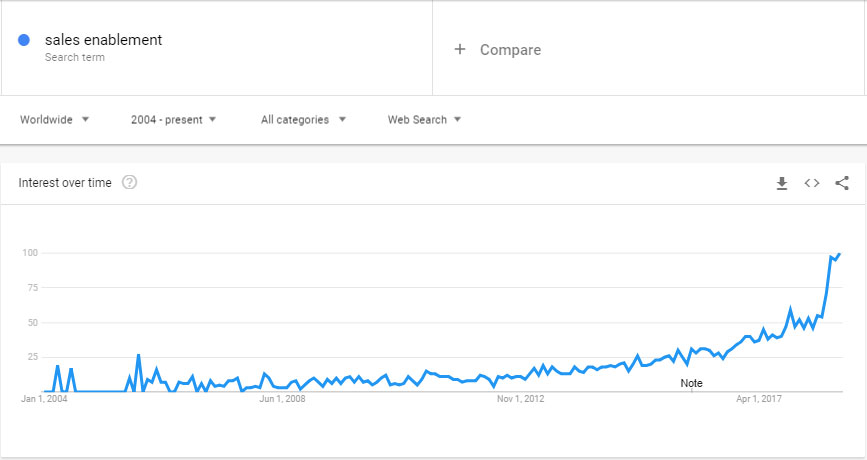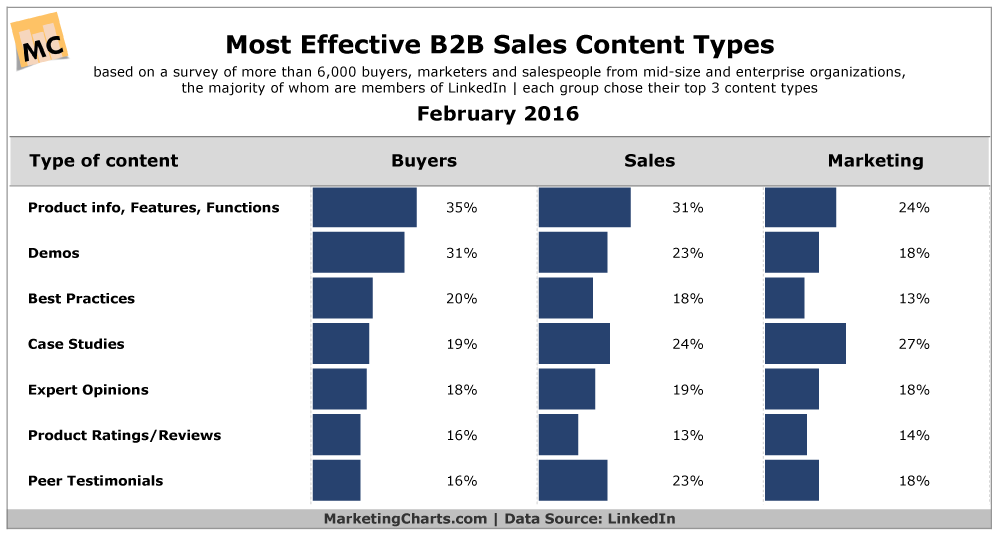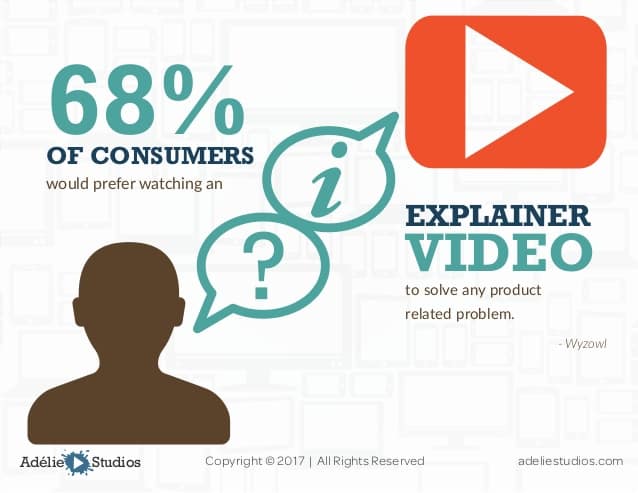There was a time when most businesses saw content as something that customers engaged with only during specific phases of the buyer’s journey.
Today, more companies understand the critical role that high-value content plays at every stage of the buyer’s journey, and in particular, the selling process.
Over the last year, searches for “sales enablement” have grown by 51.2% year-over-year.

Sales enablement content is content that sales reps can use throughout the selling process. Sales reps need the right content at the right time to effectively engage with prospects and address their concerns. According to Salesforce, 58% of pipelines stall because sales reps are unable to add value.
Buyers want to engage with more content throughout the sales process. 95% of buyers choose a provider who delivers the content to help them navigate through each stage of the buying process.
Sales enablement is all about creating alignment between marketing and sales. By working together to identify pressing questions customers have at different points in the buyer’s journey (and connecting those questions and concerns to specific customer personas), you ensure that your marketing teams are focused on creating content that will provide the most benefit to your organization. B2B organizations that have closely aligned sales and marketing operations achieve 24% faster three-year revenue growth.
As you look to grow your sales enablement content and create that alignment between sales and marketing, there are some basic tips that any organization should follow:
Audit Your Existing Content

Not all of your existing content will be suitable as sales enablement content, but some of it will be. Identifying content that closely aligns with specific questions prospects have as they make their way through the buyer’s journey and engage with sales reps will save you time and money on the content creation process at a later date.
Work with your sales reps to identify the most common questions and concerns they encounter at each point in the buyer’s journey. Additionally, source customer support questions to get an idea of where disconnects are happening between your product and your audience.
Not all of the content you identify as being good for sales enablement will be a perfect fit out of the gate. Some of it will have to be tweaked or re-worked to fit within the context you’re hoping to use it for. Make sure you have a system in place throughout your audit to ensure that you can identify which pieces will need additional work, which are ready to be used as sales enablement content as is, and which pieces have no place within your current strategy.
Use Internal Documentation as a Foundation for New Content
One often overlooked avenue for sales enablement content is internal documentation. While most of your internal documents won’t be polished enough for mass consumption, they probably cover a number of topics that can help prospects to better understand your company, processes, and product. Those insights could be useful to customers in the evaluation stage of the sales process.
Include your internal documentation in your sales enablement content audit. Bottom-of-the-funnel content, like product comparisons and product spec sheets that were never meant to be shared with prospects, may need to be altered to provide a useful piece of content that addresses very specific questions your audience has.
Let Sales Reps Help Dictate Direction
No one understands what kind of content will be helpful to the sales process more than your salespeople themselves. They’re the ones who have been talking to prospects while wishing they had supplemental material on hand to help better drive home their points or content that prospects could pass to other stakeholders in their organization.
This is why sales enablement content can be such a boon to alignment between sales and marketing teams. Working together to identify the types of content that will be most helpful to your sales teams will help to break down walls between your teams, provide insight into the ways each team operates, and set the stage for future content-centric collaboration.
Creating sales enablement content requires direct collaboration with the sales reps who are in the trenches having real conversations. Even reviewing recorded conversations can’t truly provide the insight that the content creators need to create the right content because they can never know when a sales rep wishes they had content on hand that they don’t have—and that never shows up on the record.
Work to Improve Sales Content Over Time
Sales enablement isn’t a one-and-done type of project. It’s an ongoing effort.
For example, you’ll need to shape assets for specific buyer personas. Today’s B2B buying teams are bigger than ever before. 61% of buying teams include five or more people, and more than 50% of buying teams cross borders. Each of these stakeholders has their own concerns and needs when it comes to the solutions their company invests in, and your sales reps may need content that speaks to their perspective to get them on board.
It’s nearly impossible to account for every type of stakeholder your sales reps will have to engage with through all of their different deals. As your company expands into new markets, targets new prospects, and builds new relationships, the types of sales enablement content that your sales team needs will change as well.
Sales enablement content is an up-front investment, and you should expect to have to make continual improvements and updates. Like with marketing content, needs shift over time.
Map Content to the Customer’s Journey
Using the insights you uncovered during your content audit, develop a buyer’s journey map that ties specific stages in the journey directly to different pieces of content that you expect to use at those times. Where does each asset fit into the customer journey? What kinds of questions or concerns are expressed at specific times in the buyer’s journey? Working with your sales reps to identify when the best times to use specific types of content are, the more likely the content you create will be effective.
View content you make for sales enablement purposes through the lens of the buyer’s journey. You want to make sure you create a well-rounded library that arms your sales reps with content they can use throughout the funnel.
Make sure you’re creating a balanced approach and have a wealth of engaging content at each stage of the journey. The engaging top-of-the-funnel content is just as important as the deep-dive product-related content you might find at the bottom of the sales funnel.
Not All Content is a Fit for All Sales Reps and Teams
Even in companies where sales conversations are tracked and designed meticulously, sales reps will still have their own styles for engaging with prospects. Not every rep will be able to use the same piece of content as effectively as the next. And without working with them directly, you’ll never be able to identify what types of content will be the best fit for their individual style.
Some companies have sales reps that are segmented into teams based on who they sell to, what they sell, or the strategy they use to sell it. Your content should reflect this.
Take specific accounts, industries, and verticals into account as you identify the type of sales enablement content that you would like to create. Additionally, a different approach (such as traditional sales teams versus inside sales teams) requires a different strategy and, therefore, different types of sales enablement content for the reps.
Understanding the different situations and strategies that are used when sales conversations take place is integral to creating effective sales enablement content.
Determine What Content Would Best be Presented Visually

Not all sales enablement needs to be text-based. Some information is better presented visually—particularly early in the funnel.
Identify opportunities where the content you share might be better presented in the form of an infographic or video. Prospects retain some information at a higher rate when it is presented via audio and/or video. According to Forrester, a minute of video is worth 1.8 million written words.
Sales enablement extends beyond the content you share with prospects, encompassing the internal documents and training that you make available to your sales reps. Instead of delivering written training materials to your sales reps, consider which materials might be more useful for training purposes when they’re delivered as video, audio, or another medium.
Track Content Usage and Analytics
When you deliver content to prospects, do you track how it’s used? To better understand the effectiveness of each piece, make every effort to track and optimize the content you deliver. Who’s viewing each piece? How many times are they viewing it? What areas of the content are they interacting with the most?
Like any piece of marketing content, sales enablement that’s passed from your reps to prospects should be tracked and optimized. Those insights should be used in the content creation process when creating future pieces as well. Content with high engagement rates should serve as a model for future pieces that you create.
Empower Your Reps to Make Requests
Sales enablement is about empowerment. Your sales reps need to be agile and have the ability to respond to changes in the sales process by making requests for content that will help them to secure new deals. Doing sales enablement helps facilitate alignment between your marketing and sales teams by giving them opportunities to work together on new projects that will benefit both teams.
Additionally, if they demonstrate the initiative, you should empower your sales reps to create their own content as well. While using your writers and leveraging subject matter experts in the content creation process is important, a sales rep can provide a good first draft of the type of content that they need to facilitate their own sales processes.
It may be a good idea to provide some baseline content creation training to sales reps so they can competently create new pieces to fill in gaps they identify within your sales enablement library. Your sales teams can also create internal training materials that help to facilitate new sales and improve the team across the board.
Content that Benefits Sales Reps and Marketers Alike
The big benefit of placing some of your focus on creating content specifically for use in the sales process is that many of the subjects they would like to cover will benefit your marketing teams as well.
Your marketers are always trying to identify the questions, concerns, and needs of the audience they’re marketing to. In creating content for sales reps to use throughout the buyer’s journey, both teams will gain insights that will help to create a more well-rounded approach to the content operations within your organization.
